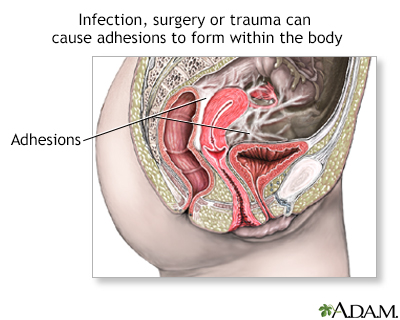Pregnancy SmartSiteTM
Pelvic adhesion; Intraperitoneal adhesion; Intrauterine adhesion DefinitionAdhesions are bands of scar-like tissue that form between two surfaces inside the body and cause them to stick together. CausesWith movement of the body, internal organs such as the bowel or uterus are normally able to shift and to slide past each other. This is because these tissues and organs in the abdominal cavity have smooth, slippery surfaces. Inflammation (swelling), surgery, or injury can cause adhesions to form and prevent this movement. Adhesions can occur almost anywhere in the body, including:
Adhesions can become larger or tighter over time. Problems may occur if the adhesions cause an organ or body part to:
The risk of forming adhesions is high after bowel or female organ surgeries. Surgery using a laparoscope is less likely to cause adhesions than open surgery. Other causes of adhesions in the abdomen or pelvis include:
Adhesions around the joints may occur:
SymptomsAdhesions in joints, tendons, or ligaments make it harder to move the joint. They may also cause pain. Adhesions in the belly (abdomen) may cause a blockage of the intestines. Symptoms include:
Adhesions in the pelvis may cause long-term (chronic) pelvic pain. Exams and TestsMost of the time, the adhesions cannot be seen using x-rays or imaging tests.
Endoscopy (a way of looking inside the body using a flexible tube that has a small camera on the end) may help diagnose adhesions:
TreatmentSurgery may be done to separate the adhesions. This can let the organ regain normal movement and reduce symptoms. However, the risk for more adhesions goes up with more surgeries. Depending on the location of the adhesions, a barrier may be placed at the time of surgery to help reduce the chance of the adhesions returning. Outlook (Prognosis)The outcome is good in most cases. Possible ComplicationsAdhesions can cause various disorders, depending on the tissues affected.
When to Contact a Medical ProfessionalContact your health care provider if you have:
ReferencesKuemmerle JF. Inflammatory and anatomic diseases of the intestine, peritoneum, mesentery, and omentum. In: Goldman L, Cooney KA, eds. Goldman-Cecil Medicine. 27th ed. Philadelphia, PA: Elsevier; 2024:chap 128. National Institute of Diabetes and Digestive and Kidney Diseases website. Abdominal adhesions. www.niddk.nih.gov/health-information/digestive-diseases/abdominal-adhesions. Updated June 2019. Accessed June 3, 2024. Yepuri N, Pruekprasert N. Cooney RN. Surgical complications. In: Townsend CM Jr, Beauchamp RD, Evers BM, Mattox KL, eds. Sabiston Textbook of Surgery. 21st ed. St Louis, MO: Elsevier; 2022:chap 12. | |
| |
Review Date: 3/31/2024 Reviewed By: LaQuita Martinez, MD, Department of Obstetrics and Gynecology, Emory Johns Creek Hospital, Alpharetta, GA. Also reviewed by David C. Dugdale, MD, Medical Director, Brenda Conaway, Editorial Director, and the A.D.A.M. Editorial team. The information provided herein should not be used during any medical emergency or for the diagnosis or treatment of any medical condition. A licensed medical professional should be consulted for diagnosis and treatment of any and all medical conditions. Links to other sites are provided for information only -- they do not constitute endorsements of those other sites. No warranty of any kind, either expressed or implied, is made as to the accuracy, reliability, timeliness, or correctness of any translations made by a third-party service of the information provided herein into any other language. © 1997- A.D.A.M., a business unit of Ebix, Inc. Any duplication or distribution of the information contained herein is strictly prohibited. | |

 Pelvic adhesions
Pelvic adhesions
